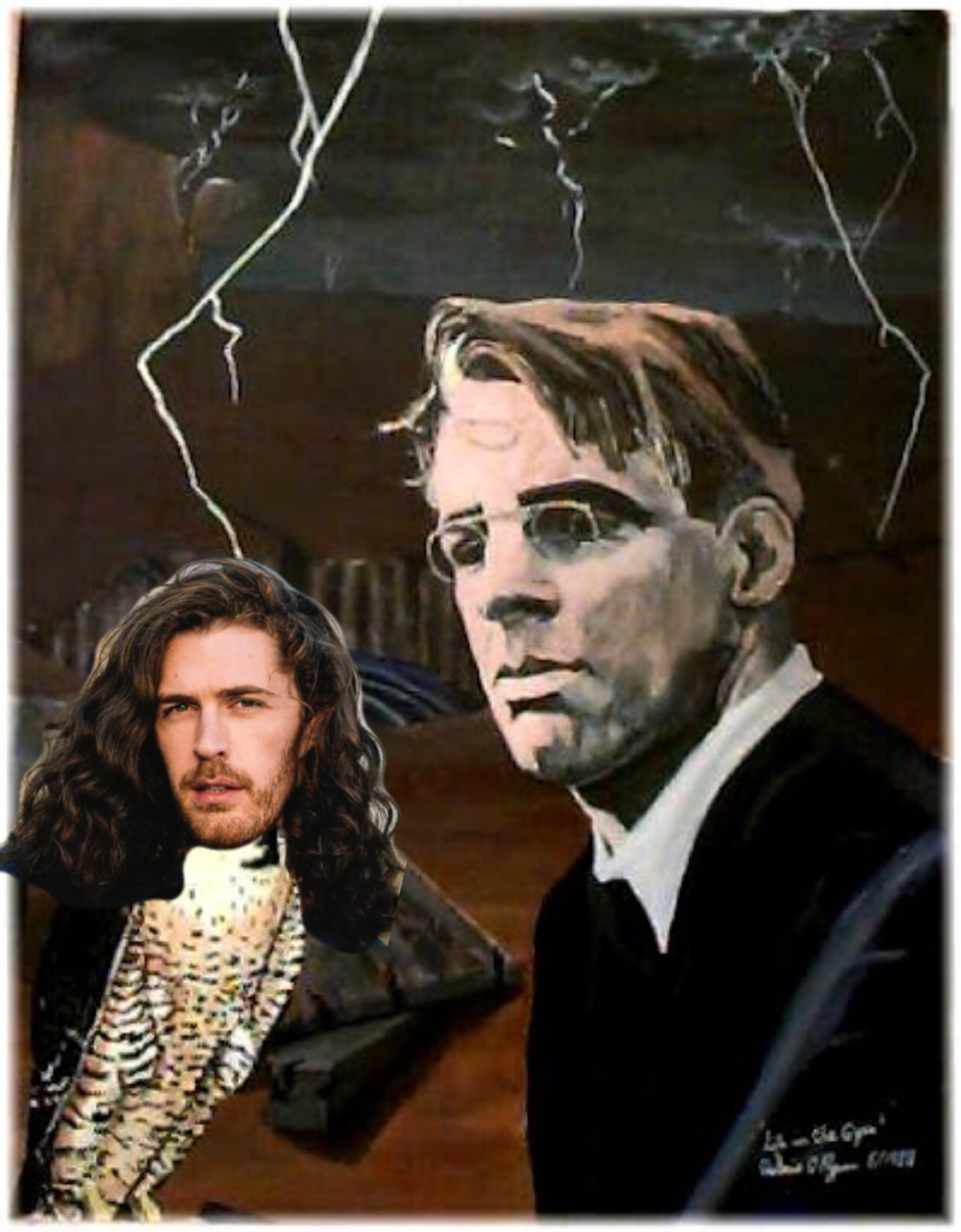Kidding. I have successfully found another way to proclaim my feelings for Irish artist and Fae Lord, Andrew Hozier-Byrne. Note: the badly photoshopped cover photo is perhaps the most un-okay thing I have done this quarantine. But bear with me, this is going to work because one of my favorite songs of Hozier’s, “NFWMB,” draws directly from Yeats’ “Second Coming.” See, I told you this was all going to work.
In class, we discussed “The Second Coming,” and its lament for WWI, human suffering via religious consequences, and ferocious anarchy–all wrapped in an inevitable cycle doomed to repeat itself interminably. However, our interpretations did not dwell on “The Second Coming” as a love poem. But that is okay, as our dear boy Hozier has already done this for us. Here are the first lines of Hozier’s “NFWMB”:
When I first saw you
The end was soon
To Bethlehem
It slouched and then
Must’ve caught a good look at you
Sound familiar? In the video below, Hozier discusses the process behind his song, intertwined with snippets of him performing it acoustically in the beautiful Killruddery House (!) in his hometown of Bray, Ireland. He remarks, “NFWMB… tries to imagine an event…of the world ending, albeit drawing from Yeats’ ‘Second Coming’” (Hozier 2018). But as mentioned, there is a bit of a twist with Hozier’s reimagining of “The Second Coming” in that he focalizes love with the same terror and inevitability of Yeats’ language: “It’s… imagining the object of your affection as just a really terrifying, terrifying individual who has a real darkness to themselves and is completely unfazed or would be completely unfazed by the worst possible scenario” (Hozier, 2018). He also discusses the idea of subverting the expectations of men as the “protectors” of women, especially in the context of a relationship, and presenting women as powerful and undaunted during terrifying situations AND WE LOVE HIM FOR IT…but I digress.
Perhaps Hozier’s translation of Yeats’ work is even more terrifying than our interpretations, for it is one approach to view Yeats’ poem as a war lamentation or an antireligion denunciation or the forewarning of impending doom; it is an entirely different approach (and perhaps even more unexpected, thus more terrifying) to shape Yeats’ words into a piece of love and affection, nursing them for the world’s end.
One of my favorite parts about this class is that it continues to equip me with new tools, histories, and contexts to dissect modern work, especially as it pertains to Irish artists. Like Yeats and other Revivalist artists, Hozier’s work often draws from Irish mythologies or the role religion plays in our lives, or as this post has hopefully exemplified, modern Irish artists often draw directly from the artists we are studying. But the inspiration does not stop with Yeats, for Hozier has also cited our friends, Oscar Wilde and James Joyce, among the many Irish writers that continue to mold his music, especially as it pertains to the Irish soundscapes he creates. We continue to see a sort of cultural performance from Irish artists, one that is very similar to that of the artists we have studied and one that has certainly influenced generations of new artists–sealing a strong nationalistic bond that continues to permeate from generation to generation within Ireland.
Parting remarks: Hozier’s “NFWMB” roots itself in the same terror and Christocentric framework of that of Yeats’ “Second Coming.” But like Yeats, Hozier interrogates the contradictions, the seemingly opposites of our world and holds them so tightly against one another that one can barely distinguish the difference. So Hozier laces the terror of “The Second Coming” with love, and in return, we love him for it.
In conclusion, I find it entirely appropriate that Hozier does all of this while looking like Jesus.

If your on-going confinement during these times does not yield enough apocalyptic spoonfuls of doom, listen to the entirety of Hozier’s “NFWMB” here: “Hozier’s ‘NFWMB,’ but by a traveling bard weaving you a tale in exchange for shelter from the storm” (https://www.youtube.com/watch?v=BTdR2jCtiVk).


OH MY GOOD GOD NOW I UNDERSTAND NFWMB. I was always like, why is he talking about Bethlehem?? I am also a HUGE fan of the wonderful, almighty Hozier. And I think you’re right, it is more terrifying to liken it to love – something that is supposed to be pure and sweet. I think it is genius to bring Hozier up because many of his music does deal with the restrictions religion puts on love and happiness, which is a common theme among the writers we’re reading about too. I am ashamed I also haven’t brought him up, but I am so glad you have. You’re brilliant and your post gives me LIFE.
This is my favorite travel diary entry by far. I don’t even have anything useful to comment, just wanted to say that.
Hi Conner, this is so awesome. While I’m not as huge of a Hozier fan, this was a really engaging read. I appreciate that he expanded the context of the poem to the nuances of romance because I believe in having an open mind for infinite interpretations of a literary work, or just anything in general.